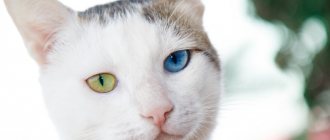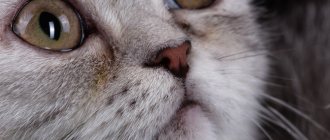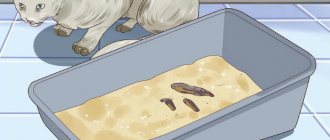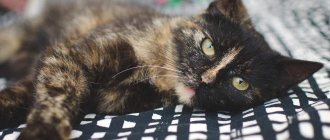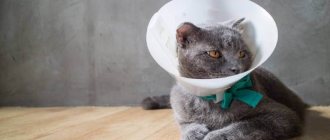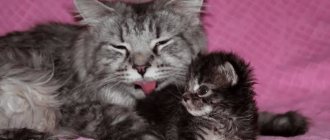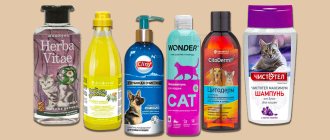It is believed that a healthy cat's nose should normally be wet and cold. However, there are situations when there are no health problems, but the nose is dry. The owner should know in which cases there is no need to worry, and what symptoms are alarming. If there is cause for alarm, the owner needs to show the pet to a veterinarian, who will diagnose and prescribe treatment.
According to veterinarians, if a cat has a pale nose for a long time, this may indicate anemia or dehydration.
What should a normal nose look like?
Wet nose
The cold and wet nose of a cat, like a dog’s, depends on the secretion of secretions from the glands that are located inside the mucous membrane. The cat also often licks the olfactory organ, which is also called the nasal speculum, to maintain moisture. The special structure of the nose and constant humidity make the organ unique, thanks to which the animal captures and recognizes odors. Each lobe looks individual, there are no identical patterns. The norm is a small amount of wet secretion that covers the entire earlobe and nasal tract. The sputum should not be abundant or collect in drops. In addition, a normal nose in a healthy cat has a natural shade - soft pink or the color of the coat. In a kitten, the olfactory organ dries out and moisturizes faster due to the still unformed heat exchange.
Nose temperature
The state of sleep helps to slow down the metabolic processes in the animal, which leads to dryness of the speculum.
The nasal mirror is not only an organ of smell, but also a regulator of the animal’s body temperature, since cats do not have sweat glands, and heat exchange occurs through the nose and paw pads. A cold and wet cat's nose indicates a normal temperature. There are situations when the nose dries out. The causes of the condition are as follows:
- Dream. When a cat sleeps, processes in the body slow down and secretion production decreases. After awakening, the organs begin to work as before and humidity is restored. In cats that have a pink tint, their noses turn white during sleep due to a decrease in blood in the capillaries. After waking up, the organ turns red again. The dark color of the nose in animals with black or gray fur also becomes lighter during sleep in the morning or afternoon. If a pet sleeps with its nose covered with its paws, it heats up from breathing, which is why sometimes a cat's nose is hot and wet.
- Stress. If the pet is nervous, the lobe not only becomes dry, but also turns white. During stressful situations, vasospasm occurs and the blood supply to the nasal mirror is disrupted.
- Outdoor game. When a cat runs and jumps quickly, there is an increased load on the heart, and blood rushes to the face. The moisture dries quickly and pink noses turn red. In dark-nosed pets, the shade of the lobe becomes darker.
- Ambient temperature. If the room is hot, moisture from the surface of the mirror evaporates faster, and the cat often washes it to moisten it.
Is it normal for my cat's nose to change color?
There is no "normal" nose color for cats because each cat can have a different shade of nose. For example, we can find cats with nose colors:
- Pink
- Black
- Chocolate
- Grey
- Spotted
The color of a cat's nose is directly related to the color of their coat. Genetic inheritance from parents or even a mutation causes a cat's nose to take on a certain color. Although a newborn kitten may have a very pink nose that takes on color as they grow, the nose will not change color in the same way as their eyes.
When a cat's nose changes color, it can be a fairly normal reaction. When a cat has a fever or is stressed, their blood vessels become congested, which can change the tone of the cat's nose. However, the actual color will not change.
© shutterstock
If our cat's nose changes color to white, it is most likely a sign of a problem. We will need to look for associated symptoms. For example, they may also suffer from weight loss, baldness, fatigue, lack of appetite, or even have injuries. Nasal pigmentation in a cat may be associated, in particular, with a decrease in the number of red blood cells.
Why the nose has changed: dangerous signs
After receiving a bruise, your pet's olfactory organ may swell.
If a cat’s nose is white or acquires a different color, alarming signs appear, this indicates the following pathological conditions:
- Injury. Occurs in a street cat or a domestic cat visiting the street when a blow to the face occurs. The nose becomes purple or blue due to a hematoma, has greatly increased in size, is swollen, the cat has difficulty breathing, and there is not intense bleeding or crusting. The nose is hot due to bruise. If it turns red, it may be a wound or scratch.
- Fungus. A yellow coating on the nose may indicate candidiasis. Symptoms of the disease also appear on the mucous membranes of the mouth. The affected area smells unpleasant, there is itching, redness and peeling of the skin in the bridge of the nose and other areas. The temperature of the nose may remain within normal limits, and there is no humidity due to damage to the mucous membrane. Often the fungus spreads to the paws, neck or abdomen.
- Ear mite. If the cat is more likely to have otodectosis, discharge from the ears spreads across the face and sticks to the top of the nose. It seems that the cat has a dirty nose. However, when a cat constantly scratches its ears, an unpleasant odor appears, and a brown coating forms near the natural bald spots on the head - this is a reason to start treatment. The nose may be warm due to irritation from an animal that is sick.
- Necrosis. When the nose darkens or turns black, becomes wet, and begins to change shape, this indicates tissue death. Depending on the type of necrosis, the cat's nose is very wet, because it is rotting, or dry, covered with a dense crust.
Infectious diseases
With developing rhinotracheitis, the fluffy suffers from a runny nose and dried crusts on the mirror.
If your pet sneezes, coughs, hides in a dark place, refuses food and water, and does not play, this means that she is sick. The temperature in cats with infectious diseases rises, the nose becomes dry and hot. When the disease is accompanied by a runny nose, it is damp due to copious mucous discharge, which forms dry crusts and prevents the pet from breathing. The condition requires immediate veterinary attention, since this is how rhinotracheitis or feline herpes manifests itself - a dangerous disease for cats.
How to treat rhinotracheitis in cats?
The treatment regimen depends on the severity of the disease. For mild rhinotracheitis, therapy is not required. It is enough to clean the animal’s nose and eyes from the resulting crusts using a cotton pad previously soaked in saline solution. If the cat’s appetite has worsened, the veterinarian will select a more nutritious and balanced diet. At this stage, it is extremely important to monitor the condition of the animal.
For severe rhinotracheitis, the veterinarian prescribes medications. They are selected individually, depending on the symptoms of the disease and the condition of the animal. The following drugs are usually prescribed:
- Antibiotics . They are recommended by a veterinarian if rhinotracheitis is accompanied by a secondary infectious disease or when concomitant infections occurring simultaneously with it are identified;
- Interferon-based products . For recurrent rhinotracheitis, such drugs are used locally - they need to be instilled several times a day into both eyes and nasal passages to prevent further development of the disease;
- Immunomodulators . They increase the animal’s body’s resistance to various diseases and strengthen cellular immunity. Additionally, immunomodulators produce antibodies against the pathogen;
- Sulfonamide drugs . They are synthetic antimicrobial agents prescribed to prevent the growth of bacteria and chlamydia. Such drugs have chemotherapeutic activity against a number of infections;
- Vitamin and mineral complexes . They are intended to restore the animal’s body and prevent the development of secondary infections. After the examination, the veterinarian will recommend which vitamin and mineral complexes are best for your pet.
In order for your cat to quickly cope with rhinotracheitis, follow all the veterinarian’s recommendations and do not self-medicate - do not risk the health of your beloved pet!
Diagnosis and treatment
If a cat has a white or bluish nose, then there is a suspicion of anemia or cardiac pathology. A red nose may indicate injury. To identify the cause, the veterinarian listens to complaints, conducts an external examination and prescribes diagnostic procedures, depending on the preliminary diagnosis, such as:
- radiography;
- ECG;
- blood chemistry;
- scraping scales from the skin to test for fungus;
- analysis of ear discharge to detect ticks;
- polymerase chain reaction to detect herpes virus.
Cat noses are treated depending on the disease. Rhinotracheitis is incurable, but an acute attack can be treated with antibiotics or antiviral drugs, which are individually prescribed by a veterinarian. For injuries, rhinoplasty is performed or anti-inflammatory drugs are used. Special drops are prescribed against fungus or ear mites. With necrosis, dead particles are eliminated.
Infectious diseases
Cats are susceptible to viral infections:
The human body is immune to these pathogens. Pets become infected through contact with sick individuals or apparently healthy virus carriers, as well as their secretions. People bring infection into the house on shoes, clothes, household items, etc.
Symptoms of viral diseases:
Complicated course of the disease leads to pneumonia, which can cause death. About 20% of people with viral infections may die. At risk: kittens, older animals, as well as individuals infected with feline immunodeficiency virus (FIV) or leukemia virus (FLV).
What does the color of sputum indicate when you cough?
Sputum that is rusty or brown in color
The rusty color of sputum when coughing, as well as its brown shades, is often found in smokers. This happens due to the accumulation of tobacco combustion products.
In other cases, a reddish-red hue of mucus is a sign of blood in the respiratory tract. However, there is no need to panic: this happens when small blood vessels rupture during a strong cough, and the darker the mucus, the more time has passed since the blood loss.
Brown and rust-colored sputum can be caused by:
- inflammation of the bronchi or lungs;
- blockage of blood vessels;
- pneumonia;
- cystic fibrosis;
- lung abscess.
Yellow sputum
Yellow bronchial mucus is common. This is a kind of response of our immune system to the appearance of infection in the respiratory tract.
The yellow tint of mucus is characteristic of:
- flu;
- ARVI;
- bronchitis;
- sinusitis.
If the sputum is yellow when coughing and contains impurities of pus, this may indicate pneumonia. The bright canary color is characteristic of pulmonary aspergillosis, a disease caused by the mold Aspergillus.
In many cases, yellow mucus appears in the initial stages of colds. As the pathological process progresses, it acquires a greenish tint.
Green sputum
Green mucus is a sign of an active bacterial infection. The causative agents can be staphylococci, streptococci, Klebsiella.
Diseases that occur with green sputum:
- sinusitis;
- sinusitis;
- purulent bronchitis;
- laryngitis;
- pneumonia;
- cystic fibrosis (sputum is produced in the form of lumps);
- lung abscess (thick green mucus with a distinct unpleasant odor).
Green sputum when coughing gets this color due to white blood cells - neutrophils. This is the most numerous group of leukocytes, and they are the ones “attracted” by the body to fight fungal and bacterial infections. Neutrophils simply absorb pathogenic microorganisms - so they always end up in the place where the pathogen appears.
Pink or red sputum
Pink sputum usually indicates mild bleeding, which is provoked by aggressive coughing attacks. However, if symptoms do not decrease for more than three days, or the sputum becomes more saturated red, you should immediately consult a doctor.
The mucus gets its red color due to the presence of blood impurities. This symptom is typical for:
- tuberculosis;
- abscess;
- pulmonary infarction;
- oncological diseases of the respiratory system;
- pulmonary edema.
In addition, foamy mucus with bloody inclusions is a characteristic sign of anthrax.
But foamy pink sputum when coughing often indicates pulmonary edema, which in turn can be caused by heart failure. The appearance of such mucus during expectoration is a reason to consult a cardiologist.
Bloody sputum often indicates a dangerous condition, so you should never hesitate to see a doctor.
White sputum
White sputum is a signal of an inflammatory process in the respiratory tract.
- It can often be observed in the initial stages of viral bronchitis (in later stages, the mucus becomes yellow or greenish).
- Another reason for the appearance of white sputum is being in an environmentally unsafe place and, as a result, intoxication of the body. It can also be caused by taking certain medications or drugs.
- If white mucus is released in the form of lumps and the consistency resembles curdled, this may be a sign of pneumonia of fungal origin. Antibiotics do not help in this situation: to treat this type of inflammation, special antifungal therapy is required.
White sputum when coughing means that the mucous membrane of the respiratory tract is swollen. Because of this, liquid transparent mucus cannot easily move through them, and gradually acquires viscosity and a white color.
Gray or blackish sputum
A light gray tint to sputum is natural for infectious diseases in their initial stages. It could be:
- acute respiratory infections;
- ARVI;
- flu.
Saturated gray or black mucus is quite rare. In particular, miners and representatives of other professions in which they have to inhale air with a large amount of suspended particles: coal dust, iron shavings, etc., suffer from a cough with the release of this kind of sputum.
Coloring substances in products such as Coca-Cola, strong tea, and dark chocolate can also give sputum a dark color.
Smoking can also cause gray and black mucus: this is typical for long-term smokers.
In some cases, the gray color of sputum when coughing indicates an advanced stage of tuberculosis, as well as cancer of the respiratory system.
What kind of nose should a healthy cat have?
A cat’s nose is a rather complex organ, which is designed for smell and detailed study of the surrounding world. Thanks to their sense of smell, cats can detect subtle odors that signal them of approaching danger, threat or prey. Also, cats can miraculously sense the scent of their owner even over long distances.
The intricate structure of the nose allows the cat to have visual defects and this will not at all interfere with her living a normal and fulfilling life. It will help her easily navigate space and independently move around rooms, looking for food and a litter tray.
This olfactory organ is an excellent indicator of health. He can provide the owner with some information about the health of his pet and suggest what to do in the future. You should not leave your cat's nose without proper care, as it is an important part of the body that requires observation and control.
Features of the structure of a cat's nose
A cat's nose is much more sensitive and powerful in its characteristics than a human nose. Receptors sensitive to various odors deliver the received information to the animal’s brain with incredible speed, having previously recognized it.
The unique structure of this organ allows the perception of odors so bright and pungent that too rich aromas can cause discomfort, allergic reactions, and dizziness in a cat. Therefore, the animal should be protected from the smell of perfume and from contact with chemicals. Also, hypersensitivity of the nose explains the dislike of cats for citrus fruits.
The structure of a cat's nose begins with two nasal openings, which are separated in the middle by elastic, soft cartilage. Its upper section consists of two ethmoid shells that lead into the nasopharynx.
Once inside, the smell disperses and then becomes more concentrated, which allows the animal to accurately determine the nature of the aroma. Also, cats retain olfactory memory for many objects.
This is due to the fact that aroma molecules can stagnate in the ethmoid turbinates of the nose and not leave them for a long time.
What functions does a cat's nose perform?
The cat's nose performs far more than just smelling functions. This most complex organ is needed for a number of tasks that help the cat not only hunt well, find food for itself and escape from enemies, but also maintain its own health:
- Thermoregulation. A cat's nose perfectly regulates the temperature of the cold air that gets inside. By warming it until it enters the lungs, the animal protects itself from hypothermia and inflammation.
- Cleaning. The animal's organ is designed like a cleaning filter. The inhaled air is pre-cleaned from all kinds of bacteria, viruses and other harmful microparticles.
- Smell. Do not forget that, first of all, a cat’s nose is a kind of navigator that provides the cat with the necessary information about the things and creatures around it.
It is worth remembering that the owners of the healthiest and most problem-free noses are cats of ordinary breeds or even outbred ones.
Thoroughbred beauties, as a result of crossbreeding, receive all kinds of deformations of the skull, including the nose.
This is especially true for Persian cats, which are obviously doomed to problems with the respiratory system, since their cartilage and bones are irregular in shape and virtually absent.
What should a healthy nose look like and what affects it?
When a cat has a cold, wet nose, it's perfect! In addition, such sensations when touched indicate not only the health of the cat’s nose, but also the general health of the animal.
What kind of nose should a cat have?
- the cat's nose is moderately wet;
- chill;
- have a light pink tint;
- have a uniform structure, without cracks or swelling.
If a cat has a dry or warm nose, this is not a reason to panic. This condition is quite logical in cases where:
- the weather is hot outside;
- the pet is sleeping or has just woken up;
- the cat was actively playing;
- the animal has suffered stress.
But it is also important to determine how long the pet’s nose remains dry. If dryness does not go away for more than 2 hours, you should pay special attention to the animal’s condition and measure its body temperature.
A cat's nose that is too pale can signal many conditions that owners should pay special attention to:
- hypothermia;
- poisoning;
- decrease in pressure and temperature;
- shock.
A white nose is also not healthy. The appearance of this organ indicates the functioning of the heart and blood system. The skin on the nose has no pigment and you can easily trace the shade of blood from it:
- Red – fever, allergies.
- White – poisoning, hypothermia.
- Blue – heart disease.
- Yellow – diseases of the liver and renal system.
When the nose is colored in a certain dark color that is natural for the color, and it is not possible to determine its condition, then an examination of the cat for preventive purposes can be carried out on the lips, eyes and ears. The eyes may become watery, and in the ears, temperature and blood vessels, which become inflamed in diseases of various types, are of particular importance.
It is important to note that a very wet nose in a cat is also not the norm; such a condition of the mucous membrane can indicate both a common cold and more complex diseases and causes of excess secretions, such as:
- allergy;
- upper respiratory tract infections;
- pneumonia;
- foreign, irritating objects in the nose;
- fungus;
- head injuries;
- bacterial infections, etc.
Nasal discharge may be thin and clear, thicker and darker, with elements of pus or blood. In any of the above cases, it is worth showing the animal to a veterinarian.
If such symptoms occur, it is worth paying attention to other factors, such as the behavioral characteristics of the pet. The cat may become restless or, on the contrary, too apathetic and lethargic. Excess nasal discharge may be accompanied by frequent sneezing, coughing and difficulty breathing, accompanied by snoring during sleep.
How should you clean your nose?
Cleaning is not one of the procedures that the owner must perform in order to ensure complete safety of his pet from diseases. Cats cope quite well with this procedure on their own. These animals are incredibly clean by nature, so if there is dirt, then after a couple or three washes the cat will calmly remove the accumulated dust or dirt.
If the pollution is still serious, and you see that the animal cannot cope, then you can try to help. In this case, you should not use cotton swabs, which will only worsen the situation and may even cause inflammation of the nasal passage. For cleaning, ordinary cotton pads soaked in warm water are suitable. Dirt must be removed carefully, as if getting it from the inside.
A healthy cat's nose is not only moist, but also clean. At the slightest contamination, the pet always washes itself with its tongue or helps itself by wetting its paw. With weakness and general malaise, cats often forget about cleanliness, and therefore a dirty nose can tell the owner about problems with the animal’s health.
Examining a pet's nose can prevent the onset of many serious and unpleasant diseases, which is why it is worth periodically palpating the nose and making sure that the pet is feeling well.


